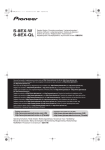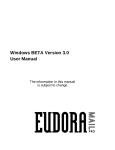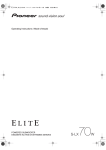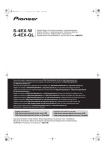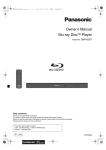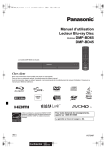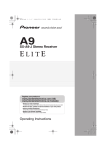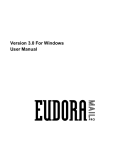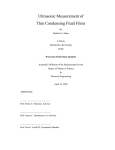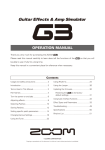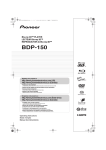Download S-W301/S-W501/S-W601 - Pioneer Electronics
Transcript
XRE3208A_S-W301W501W601_En.fm 1 ページ 2008年7月16日 水曜日 午後7時45分 S-W301/S-W501/S-W601 Operating Instructions Mode d’emploi English POWERED SUBWOOFER ENCEINTE ACTIVE D’EXTREMES GRAVES Thank you for buying this PIONEER product. Please read through these operating instructions so you will know how to operate your model properly. After you have finished reading the instructions, put them away in a safe place for future reference. In some countries or regions, the shape of the power plug and power outlet may sometimes differ from that shown in the explanatory drawings. However, the method of connecting and operating the unit is the same. IN COMBINATION WITH SPEAKERS The frequency characteristics of the S-W301/S-W501/S-W601 combined with small-size speakers are shown below. As shown in these figures, the low frequency range is improved. • These special characteristics are obtained in an echoless chamber. The effect of an additional S-W301/S-W501/S-W601 in an ordinary listening room is better than the chart indicates when positioned adequately. • The rear (surround) speakers are most effective when installed in parallel locations directly to the side, or slightly behind, the listener, at a level about 1 meter (3.3 ft.) above the listener’s ears. CAUTION: When installing the center speaker on top of the TV, be sure to secure it with tape or some other suitable means. Otherwise, the speaker may fall from the TV due to external shocks such as earthquakes, and it may lead to endangering those nearby or damaging the speaker. Small-size speakers + S-W301/S-W501/S-W601 IMPORTANT CAUTION RISK OF ELECTRIC SHOCK DO NOT OPEN The lightning flash with arrowhead symbol, within an equilateral triangle, is intended to alert the user to the presence of uninsulated "dangerous voltage" within the product's enclosure that may be of sufficient magnitude to constitute a risk of electric shock to persons. CAUTION: TO PREVENT THE RISK OF ELECTRIC SHOCK, DO NOT REMOVE COVER (OR BACK). NO USER-SERVICEABLE PARTS INSIDE. REFER SERVICING TO QUALIFIED SERVICE PERSONNEL. 1) 2) 3) 4) 5) 6) 7) The exclamation point within an equilateral triangle is intended to alert the user to the presence of important operating and maintenance (servicing) instructions in the literature accompanying the appliance. D3-4-2-1-1_En-A 11) Only use attachments/accessories specified by the manufacturer. 12) Use only with the cart, stand, tripod, bracket, or table specified by the manufacturer, or sold with the apparatus. When a cart is used, use caution when moving the cart/apparatus combination to avoid injury from tip-over. Read these instructions. Keep these instructions. Heed all warnings. Follow all instructions. Do not use this apparatus near water. Clean only with dry cloth. Do not block any ventilation openings. Install in accordance with the manufacturer’s instructions. 8) Do not install near any heat sources such as radiators, heat registers, stoves, or other apparatus (including amplifiers) that produce heat. 9) Do not defeat the safety purpose of the polarized or grounding-type plug. A polarized plug has two blades with one wider than the other. A grounding type plug has two blades and a third grounding prong. The wide blade or the third prong are provided for your safety. If the provided plug does not fit into your outlet, consult an electrician for replacement of the obsolete outlet. 10) Protect the power cord from being walked on or pinched particularly at plugs, convenience receptacles, and the point where they exit from the apparatus. 13) Unplug this apparatus during lightning storms or when unused for long periods of time. 14) Refer all servicing to qualified service personnel. Servicing is required when the apparatus has been damaged in any way, such as power-supply cord or plug is damaged, liquid has been spilled or objects have fallen into the apparatus, the apparatus has been exposed to rain or moisture, does not operate normally, or has been dropped. P1-4-2-2_En If the AC plug of this unit does not match the AC outlet you want to use, the plug must be removed and appropriate one fitted. Replacement and mounting of an AC plug on the power supply cord of this unit should be performed only by qualified service personnel. If connected to an AC outlet, the cut-off plug can cause severe electrical shock. Make sure it is properly disposed of after removal. The equipment should be disconnected by removing the mains plug from the wall socket when left unused for a long period of time (for example, when D3-4-2-2-1a_A_En on vacation). CAUTION The POWER switch on this unit will not completely shut off all power from the AC outlet. Since the power cord serves as the main disconnect device for the unit, you will need to unplug it from the AC outlet to shut down all power. Therefore, make sure the unit has been installed so that the power cord can be easily unplugged from the AC outlet in case of an accident. To avoid fire hazard, the power cord should also be unplugged from the AC outlet when left unused for a long period of time (for example, when D3-4-2-2-2a_A_En on vacation). This product is for general household purposes. Any failure due to use for other than household purposes (such as long-term use for business purposes in a restaurant or use in a car or ship) and which requires repair will be charged for even during the K041_En warranty period. WARNING: Handling the cord on this product or cords associated with accessories sold with the product will expose you to chemicals listed on proposition 65 known to the State of California and other governmental entities to cause cancer and birth defect or other reproductive harm. D36-P4_A_En VENTILATION CAUTION POWER-CORD CAUTION When installing this unit, make sure to leave space around the unit for ventilation to improve heat radiation (at least 25 cm at top, 15 cm at rear, and 10 cm at each side). Handle the power cord by the plug. Do not pull out the plug by tugging the cord and never touch the power cord when your hands are wet as this could cause a short circuit or electric shock. Do not place the unit, a piece of furniture, etc., on the power cord, or pinch the cord. Never make a knot in the cord or tie it with other cords. The power cords should be routed such that they are not likely to be stepped on. A damaged power cord can cause a fire or give you an electrical shock. Check the power cord once in a while. When you find it damaged, ask your nearest PIONEER authorized service center or your dealer for a replacement. S002*_En WARNING Slots and openings in the cabinet are provided for ventilation to ensure reliable operation of the product, and to protect it from overheating. To prevent fire hazard, the openings should never be blocked or covered with items (such as newspapers, table-cloths, curtains) or by operating the D3-4-2-1-7b_A_En equipment on thick carpet or a bed. To prevent a fire hazard, do not place any naked flame sources (such as a lighted candle) on the D3-4-2-1-7a_A_En equipment. This product contains mercury. Disposal of this material may be regulated due to environmental considerations. For disposal or recycling information, please contact your local authorities or the Electronics K057_En Industries Alliance : www.eiae.org. WARNING WARNING This equipment is not waterproof. To prevent a fire or shock hazard, do not place any container filled with liquid near this equipment (such as a vase or flower pot) or expose it to dripping, splashing, rain D3-4-2-1-3_B_En or moisture. Before plugging in for the first time, read the following section carefully. The voltage of the available power supply differs according to country or region. Be sure that the power supply voltage of the area where this unit will be used meets the required voltage (e.g., 230 V D3-4-2-1-4_A_En or 120 V) written on the rear panel. WARNING Operating Environment Operating environment temperature and humidity: +5 ºC to +35 ºC (+41 ºF to +95 ºF); less than 85 %RH (cooling vents not blocked) Do not install this unit in a poorly ventilated area, or in locations exposed to high humidity or direct sunlight (or strong artificial light) D3-4-2-1-7c_A_En For U.S. Model signal, and when set to 0º, it is in the same phase as the input signal. • Normally, the switch is set to 0º. But when the sound connection between the subwoofer and the left and right speakers sounds unnatural, try switching to 180º and set the switch in the position where the sound is natural. • When using two or more subwoofers together, make sure that the phase switch of all of them are set to the same position. 7 Auto Standby switch (AUTO STANDBY) Switches the Auto Standby feature on/off. When switched ON (the default setting is OFF), the Auto Standby feature becomes active. In this mode, if there is no input signal for 12 minutes the system automatically switches to standby. The power is automatically switched on again if an input signal is detected. NOTE: There may be cases where a connected component outputs noise or some other non-audio signal which causes this system to automatically power on when in Auto Standby mode. If this happens, switch off the Auto Standby mode and switch the system on/off manually. 8 Line Level Input terminal (LINE LEVEL INPUT) Connect to the SUBWOOFER PREOUT terminal of an amplifier or receiver, with the specially provided RCA plug cord. 9 Line Level Output terminal (LINE LEVEL OUTPUT) Used for connecting other equipment through the amplifier. The signal output from this jack is not affected in any way by the settings of the various controls on the unit. REAR PANEL 10 AC CORD Connect the AC cord to a AC socket (in the room). 2 POWER VOLUME MAX MIN CROSSOVER 3 200 Hz 50 Hz BYPASS ON OFF PHASE AUTO STANDBY ON OFF LINE LEVEL OUTPUT INPUT 4 5 6 7 8 9 CONNECTIONS Before making or changing any connections, switch off the power and disconnect both this unit and the amplifier/receiver from the AC outlet. LINE LEVEL CONNECTION Rear Panel Supplied RCA plug cord 10 1 Power Indicator (STANDBY/ON) Lights blue when the power has been switched ON. When AUTO STANDBY switch is set to ON, lights blue whenever the speaker receive an audio signal. If the power is switched OFF only briefly, the indicator lights blue when power is restored. If no signal is present for more than 12 minutes, the subwoofer automatically reverts to standby mode and the power indicator lights red. If, subsequently, a signal is received, power automatically comes back on and the power indicator lights blue. NOTE: • If you are planning on switching the unit OFF for a long period of time, make sure to check that the indicator light has gone out after switching OFF. 2 Power switch (POWER) Switches the subwoofer between ON and OFF. 3 Volume knob (VOLUME) Sets the subwoofer volume. • Turn the knob slowly from the MIN position. • With this unit, the bass level can be independently set, so do not turn up the bass on the AV amplifier. 4 Crossover knob (CROSSOVER) When using the subwoofer, set the upper frequency limit for the subwoofer (50 Hz to 200 Hz) so that it complements the output from your other speakers. When using the bass management features of an AV receiver, set to BYPASS ON in order to use the low-pass filter of the AV receiver for high quality sound. INSTALLATION Speaker Installation • Subwoofer Installation Criteria 1 1 Left speaker 2 Right speaker 3 Recommended installation range for the subwoofer 4 Listening position 2 3 4 The subwoofer plays back the bass in monaural, making use of the fact that the human ear is not very sensitive to the direction of low-pitched sound. Because of this, the subwoofer can be installed almost anywhere. If it is installed too far away, however, the sound from the other speakers may become unnatural. • An example of speaker positioning 1 Front left speaker 2 3 1 2 Center speaker 3 Front right speaker 4 Subwoofer 5 Listening area 6 Rear left speaker 4 7 Rear right speaker The subwoofer is not magnetically shielded and so should not be placed near a TV or monitor. Magnetic storage media (such as floppy discs and tape or video cassettes) should also not be kept close to the subwoofer. • Do not place the speaker on an unstable surface, as doing so may cause the speaker to fall and cause damage or bodily injury. • Do not place cups, glasses, or other containers with fluids on top of the units, since the units may be damaged if the liquid spills. • The installation location selected should have a sturdy floor surface. Mounting the speaker on a long-pile carpet should be avoided, since the carpet may touch the driver’s diaphram, causing distorted sound. • Please install this unit away from the antenna cable of the tuner, as noise can be caused with installation close to the antenna cable. In such a case, use this unit at a position away from the antenna and the antenna cable, or when playback of extra bass is not required, switch off the power for this unit. MAINTENANCE OF EXTERNAL SURFACES: • Clean the surface by wiping with a soft, dry cloth. • When the surfaces are very dirty, wipe with a soft cloth dipped in some neutral cleanser diluted five or six times with water, and wrung out well, and then wipe again with a dry cloth. Do not use furniture wax or cleaners. • Never use thinners, benzine, insecticide sprays and other chemicals on or near this unit, since these will corrode the surfaces. 7 • Position the left and right channel speakers at equal distances from the TV set and approximately 1.8 meters (6 ft.) from each other. • Install the center speaker above or below the TV so that the sound of the center channel is localized at the TV screen. n 150 W (S-W301)/170 W (S-W501)/180 W (S-W601) (RMS) power with AB class amplifier that serves audio and video software playback such as Dolby Digital with a wide dynamic range. n Equipped with 20 cm (S-W301)/25 cm (S-W501)/30 cm (S-W601) driver n Crossover frequency can be set to 50 Hz to 200 Hz. 1 • With playback of Dolby Digital, establishment of a special channel for the subwoofer is recommended; and with playback of LFE (Low Frequency Effect: sound effect like the rumbling of the earth, whose purpose is to intensify the force of the video), the S-W301/S-W501/SW601 is especially effective. NOTES: FEATURES STANDBY/ON FREQUENCY (Hz) 6 • RCA plug cord x1 • Operating instructions FRONT PANEL Small-size speakers • Do not attach the subwoofer to the wall or ceiling. They may fall off and cause injury. • Install the unit in a well-ventilated location where it will not be exposed to high temperatures and high humidity. • Do not place the unit near stoves or other heating equipment or at locations exposed to direct sunlight, as these can have an adverse effect on the cabinet and internal components. Also, do not install the unit where there is too much dust or high humidity, as these can cause malfunctioning or breakdowns. (Avoid cooking tables and other locations where the unit would be exposed to heat, steam and soot.) • Do not place heavy or large objects on top of the speaker. Doing so could provoke the speaker to fall, causing damages or bodily injury. If speakers fall from their installation locations, they may suffer irreparable cracks in their finish. • Keep the unit away from devices such as cassette decks which are sensitive to magnetic fields. 5 ACCESSORY ITEMS PANEL FACILITIES RESPONCE (dB) Installation Precautions This connection is for an amplifier or receiver equipped with a SUBWOOFER PREOUT terminal. Connect to the LINE LEVEL INPUT terminal on this unit, using the specially provided RCA plug cord. NOTE: • When connected to the PREOUT terminal for surround center channel on the amplifier or receiver, the bass is heard only on the center channel, so it will be insufficient. OPERATION For details regarding operating part functions, refer to PANEL FACILITIES above. 1. Turn the POWER switch (2) ON. • If the unit’s power cord is connected to a switched AC outlet on the amplifier or receiver and the switch is left ON, the unit can be turned ON/OFF together with the amplifier or receiver. • If the unit cannot be connected to the amplifier or receiver, turn the power to the amplifier or receiver ON before turning the power to the unit ON. When turning the power OFF, turn the power to the unit OFF before turning the power to the amplifier or receiver OFF. 2. Operate the amplifier or receiver and adjust the volume of the other speakers. 5 Bypass switch (BYPASS) When set to ON, the audio signal is routed to the woofer unit, bypassing the amplifier’s crossover circuit. 3. Adjust the volume of the bass with the VOLUME knob (3). • When necessary, operate the CROSSOVER knob (4) and PHASE switch (6), and then adjust with the VOLUME knob (3). 6 Phase switch (PHASE 0º /180º) When set to 180º, the output phase becomes the reverse of the input 4. Turn the POWER switch (2) OFF. • The power indicator disappears. TROUBLESHOOTING Incorrect operations are often mistaken for trouble and malfunctions. If you think that there is something wrong with this component, check the points below. Sometimes the trouble may lie in another component. Investigate the other components and electrical appliances being used. If the trouble cannot be rectified even after exercising the checks listed below, ask your nearest PIONEER authorized service center or your dealer to carry out repair work. SYMPTOM CAUSE • Power supply plug is not correctly inserted. (Indicator does not light up when power switch is turned on.) 1 No power is being supplied REMEDY • Insert plug securely. 2 No sound (Indicator is lit.) • Connection of accessory RCA plug cord is wrong or disconnected. • VOLUME knob is set to MIN. • Check again and connect correctly. 3 Sound is distorted. • Level is too high. • Input level is too high. • Turn the VOLUME knob counter-clockwise to lower the level. • Turn the amplifier’s output level (volume, bass control, bass boost) counter-clockwise to lower the level. 4 Howling noise occurs. • No power supplied to the amplifier. • Subwoofer level is set too high. • Connect an amplifier and supply power. • Place the subwoofer a good distance from speakers. Turn the VOLUME knob counter-clockwise to lower the volume. 5 Much noise when listening to AM or FM broadcasts. • The AM loop antenna or the FM indoor • Increase the distance between the AM or FM antenna (for antenna is close to this unit. indoor use) and this unit. • Turn clockwise slowly. SPECIFICATIONS Cabinet .....................Bass-reflex, floor-standing type Speaker S-W301.............................................20 cm cone type S-W501.............................................25 cm cone type S-W601.............................................30 cm cone type Power Amplifier Continuous Power Output (RMS) S-W301........................................150 W/6 Ω (100 Hz) S-W501........................................170 W/6 Ω (100 Hz) S-W601........................................180 W/6 Ω (100 Hz) Input (sensitivity at 100 Hz) LINE LEVEL (RCA jack) ..................................200 mV Output (Level at 100 Hz) LINE LEVEL (RCA jack) ..................................200 mV Selectable CROSSOVER Frequencies .............................................................. 50 Hz to 200 Hz Outline Dimension S-W301 .............. 360 mm (W) x 360 mm (H) x 398.5 mm (D) 14.2 in. (W) x 14.2 in. (H) x 15.7 in. (D) S-W501 .............. 360 mm (W) x 380 mm (H) x 418.5 mm (D) 14.2 in. (W) x 15.0 in. (H) x 16.5 in. (D) S-W601 .............. 360 mm (W) x 430 mm (H) x 438.5 mm (D) 14.2 in. (W) x 16.9 in. (H) x 17.3 in. (D) Weight (without package) S-W301......................................... 14.6 kg/32 lb. 4 oz. S-W501......................................... 15.6 kg/34 lb. 7 oz. S-W601....................................... 17.2 kg/37 lb. 15 oz. Power Requirements................................120 V, 60 Hz Power Consumption...........................................144 W Power Consumption in standby .........................0.5 W Accessories......................................RCA plug cord x1 Operating instructions Specifications and design subject to possible modification without notice, due to improvements. We Want You Listening For A Lifetime Selecting fine audio equipment such as the unit you’ve just purchased is only the start of your musical enjoyment. Now it’s time to consider how you can maximize the fun and excitement your equipment offers. This manufacturer and the Electronic Industries Association’s Consumer Electronics Group want you to get the most out of your equipment by playing it at a safe level. One that lets the sound come through loud and clear without annoying blaring or distortion-and, most importantly, without affecting your sensitive hearing. Sound can be deceiving. Over time your hearing “comfort level” adapts to higher volumes of sound. So what sounds “normal” can actually be loud and harmful to your hearing. Guard against this by setting your equipment at a safe level BEFORE your hearing adapts. Used wisely, your new sound equipment will provide a lifetime of fun and enjoyment. Since hearing damage from loud noise is often undetectable until it is too late, this manufacturer and the Electronic Industries Association’s Consumer Electronics Group recommend you avoid prolonged exposure to excessive noise. This list of sound levels is included for your protection. Decibel Level Example 30 40 50 60 70 80 Quiet library, soft whispers Living room, refrigerator, bedroom away from traffic Light traffic, normal conversation, quiet office Air conditioner at 20 feet, sewing machine Vacuum cleaner, hair dryer, noisy restaurant Average city traffic, garbage disposals, alarm clock at two feet. THE FOLLOWING NOISES CAN BE DANGEROUS UNDER CONSTANT EXPOSURE To establish a safe level: • Start your volume control at a low setting. • Slowly increase the sound until you can hear it comfortably and clearly, and without distortion. 90 Subway, motorcycle, truck traffic, lawn mower 100 Garbage truck, chain saw, pneumatic drill 120 Rock band concert in front of speakers, thunderclap 140 Gunshot blast, jet plane 180 Rocket launching pad Once you have established a comfortable sound level: • Set the dial and leave it there. Information courtesy of the Deafness Research Foundation. Taking a minute to do this now will help to prevent hearing damage or loss in the future. After all, we want you listening for a lifetime. S001_En PIONEER CORPORATION 4-1, Meguro 1-Chome, Meguro-ku, Tokyo 153-8654, Japan PIONEER ELECTRONICS (USA) INC. is a trademark placed on a product with Pioneer’s Phase Control technology. This technology enables high-grade sound reproduction through each component by improving overall phase matching. P.O. BOX 1540, Long Beach, California 90801-1540, U.S.A. TEL: (800) 421-1404 PIONEER ELECTRONICS OF CANADA, INC. 300 Allstate Parkway, Markham, Ontario L3R 0P2, Canada TEL: 1-877-283-5901, 905-479-4411 PIONEER EUROPE NV Haven 1087, Keetberglaan 1, B-9120 Melsele, Belgium TEL: 03/570.05.11 PIONEER ELECTRONICS ASIACENTRE PTE. LTD. 253 Alexandra Road, #04-01, Singapore 159936 TEL: 65-6472-7555 Published by Pioneer Corporation. Copyright © 2008 Pioneer Corporation. All rights reserved. PIONEER ELECTRONICS AUSTRALIA PTY. LTD. 178-184 Boundary Road, Braeside, Victoria 3195, Australia, TEL: (03) 9586-6300 PIONEER ELECTRONICS DE MEXICO S.A. DE C.V. Blvd.Manuel Avila Camacho 138 10 piso Col.Lomas de Chapultepec, Mexico,D.F. 11000 TEL: 55-9178-4270 K002_B_En Français 1 ページ 2008年7月16日 水曜日 午後7時47分 Nous vous remercions pour cet achat d’un produit PIONEER. Nous vous demandons de lire soigneusement ce mode d’emploi; vous serez ainsi à même de faire correctement fonctionner l’appareil. Après avoir bien lu le mode d’emploi, le ranger dans un endroit sûr pour pouvoir s’y référer ultérieurement. Dans certains pays ou certaines régions, la forme de la fiche d’alimentation et de la prise d’alimentation peut différer de celle qui figure sur les schémas, mais les branchements et le fonctionnement de l’appareil restent les mêmes. IMPORTANT ATTENTION DANGER D´ELECTROCUTION NE PAS OUVRIR Ce symbole de l’éclair, placé dans un triangle équilatéral, a pour but d’attirer l’attention de l’utilisateur sur la présence, à l’intérieur du coffret de l’appareil, de “tensions dangereuses” non isolées d’une grandeur suffisante pour représenter un risque d’électrocution pour les êtres humains. ATTENTION: POUR ÉVITER TOUT RISQUE D’ÉLECTROCUTION, NE PAS ENLEVER LE COUVERCLE (NI LE PANNEAU ARRIÈRE). AUCUNE PIÈCE RÉPARABLE PAR L’UTILISATEUR NE SE TROUVE À L’INTÉRIEUR. CONFIER TOUT ENTRETIEN À UN PERSONNEL QUALIFIÉ UNIQUEMENT. PRÉCAUTION DE VENTILATION Lors de l’installation de l’appareil, veillez à laisser un espace suffisant autour de ses parois de manière à améliorer la dissipation de chaleur (au moins 25 cm sur le dessus, 15 cm à l’arrière et 10 cm de chaque côté). AVERTISSEMENT Les fentes et ouvertures du coffret sont prévues pour la ventilation, pour assurer un fonctionnement stable de l’appareil et pour éviter sa surchauffe. Pour éviter les risques d’incendie, ne bouchez jamais les ouvertures et ne les recouvrez pas d’objets, tels que journaux, nappes ou rideaux, et n’utilisez pas l’appareil posé sur un tapis épais ou D3-4-2-1-7b_A_Fr un lit. Ce point d’exclamation, placé dans un triangle équilatéral, a pour but d’attirer l’attention de l’utilisateur sur la présence, dans les documents qui accompagnent l’appareil, d’explications importantes du point de vue de l’exploitation ou de l’entretien. D3-4-2-1-1_Fr NOTE IMPORTANTE SUR LE CABLE D’ALIMENTATION Cet appareil n’est pas étanche. Pour éviter les risques d’incendie et de décharge électrique, ne placez près de lui un récipient rempli d’eau, tel qu’un vase ou un pot de fleurs, et ne l’exposez pas à des gouttes d’eau, des éclaboussures, de la pluie D3-4-2-1-3_A_Fr ou de l’humidité. Tenir le câble d’alimentation par la fiche. Ne pas débrancher la prise en tirant sur le câble et ne pas toucher le câble avec les mains mouillées. Cela risque de provoquer un court-circuit ou un choc électrique. Ne pas poser l’appareil ou un meuble sur le câble. Ne pas pincer le câble. Ne pas faire de noeud avec le câble ou l’attacher à d’autres câbles. Les câbles d’alimentation doivent être posés de façon à ne pas être écrasés. Un câble abîmé peut provoquer un risque d’incendie ou un choc électrique. Vérifier le câble d’alimentation de temps en temps. Contacter le service après-vente PIONEER le plus proche ou le revendeur pour un remplacement. S002*_Fr Avant de brancher l’appareil pour la première, lisez attentivement la section suivante. La tension de l’alimentation électrique disponible varie selon le pays ou la région. Assurez-vous que la tension du secteur de la région où l’appareil sera utilisé correspond à la tension requise (par ex. 230 V ou 120 V), indiquée sur le panneau arrière. D3-4-2-1-4_A_Fr AVERTISSEMENT Pour éviter les risques d’incendie, ne placez aucune flamme nue (telle qu’une bougie allumée) sur D3-4-2-1-7a_A_Fr l’appareil. Les caractéristiques de fréquence du S-W301/S-W501/S-W601 lorsqu’il est utilisé en combinaison avec des enceintes acoustiques de petite taille sont indiquées ci-dessous. Comme on peut le voir sur ce graphique, la gamme des basses fréquences est sensiblement améliorée. • Ces caractéristiques spéciales sont obtenues dans une chambre sans écho. L’effet produit par l’ajout d’un S-W301/S-W501/S-W601 dans une salle d’écoute ordinaire est supérieur à l’effet indiqué sur le graphique, à condition que le subwoofer soit correctement placé. Milieu de fonctionnement ATTENTION L’interrupteur POWER de cet appareil ne coupe pas complètement celui-ci de sa prise secteur. Comme le cordon d’alimentation fait office de dispositif de déconnexion du secteur, il devra être débranché au niveau de la prise secteur pour que l’appareil soit complètement hors tension. Par conséquent, veillez à installer l’appareil de telle manière que son cordon d’alimentation puisse être facilement débranché de la prise secteur en cas d’accident. Pour éviter tout risque d’incendie, le cordon d’alimentation sera débranché au niveau de la prise secteur si vous prévoyez une période prolongée de non utilisation (par exemple avant un départ en vacances). Température et humidité du milieu de fonctionnement : De +5 ºC à +35 ºC (de +41 ºF à +95 ºF); Humidité relative inférieure à 85 % (orifices de ventilation non obstrués) N’installez pas l’appareil dans un endroit mal ventilé ou un lieu soumis à une forte humidité ou en plein D3-4-2-1-7c_A_Fr soleil (ou à une forte lumière artificielle). Enceinte de petite taille FREQUENCE (Hz) • Il est recommandé de réserver un canal spécial pour le subwoofer en cas de reproduction d’un programme Dolby Digital. Le S-W301/SW501/S-W601 est particulièrement efficace en cas de reproduction d’un LFE (effet de basse fréquence : destiné à donner plus d’intensité à la vidéo). INSTALLATION Installation des enceintes • Critères d’installation du subwoofer 1 2 1 Enceinte gauche 2 Enceinte droite 3 Position préconisée pour le subwoofer 4 Position d’écoute 3 4 ACCESSOIRES FOURNIS CARACTERISTIQUES • Câble à prise RCA x 1 • Mode d’emploi n Puissance efficace de 150 W (S-W301)/170 W (S-W501)/180 W (SW601) (RMS) avec amplificateur de classe AB, servant un logiciel audio et vidéo reproduit comme Dolby Digital avec une large plage dynamique. n Equipé d’un haut-parleur de 20 cm (S-W301)/25 cm (S-W501)/30 cm (S-W601) n La fréquence de recouvrement peut être réglée entre 50 Hz et 200 Hz. ATTENTION: Si vous installez l’enceinte centrale sur le téléviseur, assurez-vous de le fixer avec du ruban adhésif ou par un autre moyen. Sinon, l’enceinte risque de tomber à cause de chocs extérieurs à l’appareil, comme des tremblements de terre, et vous pourriez mettre en danger les personnes à proximité ou l’enceinte pourrait être endommagée. Précautions d’installation D3-4-2-2-2a_A_Fr Ce produit est destiné à une utilisation domestique générale. Toute panne due à une utilisation autre qu'à des fins privées (comme une utilisation à des fins commerciales dans un restaurant, dans un autocar ou sur un bateau) et qui nécessite une réparation sera aux frais du client, même pendant la K041_Fr période de garantie. • Les enceintes arrière (ambiophoniques) donnent les meilleurs résultats lorsqu’elles sont placées de manière symétrique par rapport à la position d’écoute, au même niveau ou légèrement derrière, et à environ 1 mètre au-dessus du niveau des oreilles d’une personne assise. Enceinte de petite taille + S-W301/S-W501/S-W601 D3-4-2-2-1a_A_Fr AVERTISSEMENT AVERTISSEMENT Si la fiche d’alimentation secteur de cet appareil ne convient pas à la prise secteur à utiliser, la fiche doit être remplacée par une appropriée. Ce remplacement et la fixation d’une fiche secteur sur le cordon d’alimentation de cet appareil doivent être effectués par un personnel de service qualifié. En cas de branchement sur une prise secteur, la fiche de coupure peut provoquer une sérieuse décharge électrique. Assurez-vous qu’elle est éliminée correctement après sa dépose. L’appareil doit être déconnecté en débranchant sa fiche secteur au niveau de la prise murale si vous prévoyez une période prolongée de non utilisation (par exemple avant un départ en vacances). UTILISATION COMBINEE AVEC DES ENCEINTES ACOUSTIQUES REPONSE (dB) XRE3208A_S-W301W501W601_Fr.fm Le subwoofer restitue les graves en monophonie, en profitant du fait que l’oreille humaine n’est pas capable de localiser les sons graves. Pour cette raison, ce subwoofer peut être installé pratiquement n’importe où. Toutefois, s’il est installé trop loin, le son des autres hautparleurs risque de ne plus être naturel. • Emplacements types des enceintes 1 Enceinte avant 2 3 1 gauche 2 Enceinte centrale 3 Enceinte avant droite 4 Subwoofer 4 5 Zone d’écoute 6 Enceinte arrière gauche 5 7 Enceinte arrière droite 6 • Ne fixez pas le caisson de graves sur un mur ou au plafond, car il pourrait tomber et provoquer des blessures. • Installer le subwoofer dans un endroit bien ventilé où il ne sera pas soumis à une humidité ou à des températures excessives. • Ne pas placer le subwoofer à proximité d’un radiateur, ou autre appareil de chauffage, et ne pas l’exposer aux rayons directs du soleil car cela risquerait d’endommager le coffret ou les composants internes. Ne pas le placer non plus dans un endroit excessivement poussiéreux ou humide car ceci pourrait provoquer des anomalies de fonctionnement ou une panne. (Eviter de le placer sur une table de cuisine ou autres emplacements où il serait soumis à la chaleur, à la vapeur ou à la suie.) • Ne pas poser d’objets lourds ou volumineux sur le dessus de l’enceinte, car ceci pourrait provoquer sa chute et entraîner des dégâts ou des blessures. Si les enceintes devaient tomber, leur finition pourrait subir des fissures irréparables. • Ne pas placer le subwoofer à proximité d’un appareil, comme par exemple un magnétophone, susceptible d’être affecté par les champs magnétiques. Comme le caisson de basse n’est pas blindé magnétiquement, ne le placez pas à proximité d’un téléviseur ou d’un moniteur. En plus, tout support magnétique de données (tels que disquettes, bandes ou cassettes vidéo) doit être placé loin du caisson de basses. • Ne pas placer l’enceinte sur une surface instable, car elle pourrait tomber et provoquer des dégâts ou des blessures. • Ne pas poser de tasses, verres ou autres récipients contenant un liquide sur le dessus des appareils car ils pourraient être endommagés si du liquide devait y pénétrer. • L’emplacement d’installation choisi doit être la surface d’un plancher solide. Eviter de poser l’enceinte sur un tapis à longs poils, car ils pourraient toucher le diaphragme et provoquer une distorsion des sons. • Prière d’installer cette unité à distance du câble d’antenne du tuner, car des parasites peuvent être provoqués par une installation proche du câble d’antenne. Dans ce cas, utiliser cette unité à une position écartée de l’antenne et du câble d’antenne, ou si la reproduction de basses supplémentaires n’est pas nécessaire, couper l’alimentation de cette unité. ENTRETIEN DES SURFACES EXTERNES: • Nettoyez la surface en frottant avec un linge doux et sec. • Lorsque les surfaces sont extrêmement sales, utiliser un chiffon doux et un produit détergent neutre dilué dans cinq ou six volumes d’eau. Bien tordre le chiffon avant de nettoyer les surfaces. Les essuyer ensuite avec un chiffon sec. Ne jamais utiliser de produits de nettoyage ou de la cire pour meubles. • Ne jamais utiliser de diluant, benzine, bombe insecticide et autres produits chimiques à proximité de cette enceinte car ces produits détérioreraient le fini de surface. 7 REMARQUES: • Placer l’enceinte droite et l’enceinte gauche à égale distance du récepteur de télévision et à environ 1,8 mètre l’une de l’autre. • Installez l’enceinte centrale au-dessus ou en dessous du téléviseur, de façon à ce que le son du canal central provienne de l’écran du téléviseur. DESCRIPTION DE LA FACE AVANT ET DE LA FACE ARRIERE FACE AVANT 6 Sélecteur de phase (PHASE 0º /180º) Lors d’un réglage sur 180º , la phase de sortie devient l’inverse du signal d’entrée; lors d’un réglage sur 0º, elle est la même que le signal d’entrée. • Ce sélecteur doit être normalement réglé sur 0º, mais lorsque l’équilibre du son entre l’enceinte droite, l’enceinte gauche et le subwoofer ne semble pas naturel, essayer 180º et laisser le sélecteur à la positon donnant le résultat le plus naturel. • A l’emploi de deux ou plusieurs subwoofers, veiller à ce que le sélecteur de phase de chacun d’eux soit réglé à la même position. 2. Faire fonctionner l’amplificateur ou le récepteur et ajuster le volume des autres haut-parleurs. 7 Interrupteur d’attente automatique (AUTO STANDBY) Il active et désactive la fonction de mise en attente automatique. Lorsque la fonction est en service (ON) (ce réglage est désactivé (OFF) par défaut), la mise en attente automatique agit. Dans ce cas, si aucun signal n’est entré pendant 12 minutes, le système passe automatiquement en mode d’attente. L’alimentation est rétablie automatiquement dès qu’un signal d’entrée est détecté. Il arrive souvent que des anomalies de fonctionnement ou des problèmes apparents soient dus à de simples erreurs de manipulation. Si cette enceinte semble ne pas fonctionner correctement, contrôler les points suivants. Parfois un autre élément de la chaîne est à l’origine du problème. Contrôler tous les éléments et accessoires électriques utilisés. Si l’origine du problème n’a pas pu être trouvée après avoir effectué les contrôles suivants, s’adresser au service après-vente PIONEER le plus proche ou à un distributeur. REMARQUE: • Des cas peuvent se présenter où un composant raccordé émet des parasites ou d’autres signaux nonaudio qui provoquent une remise sous tension du système alors qu’il est en mode d’attente automatique. Dans ce cas, désactivez (OFF) le mode d’attente automatique et mettez le système manuellement en service ou hors service. STANDBY/ON 1 3. Ajuster le volume des graves par le bouton VOLUME (3). • Lorsque nécessaire, utiliser le bouton de réglage CROSSOVER (4) et le sélecteur PHASE (6) et régler ensuite le volume avec le bouton VOLUME (3). DEPANNAGE SYMPTÔME 2 POWER VOLUME MAX MIN CROSSOVER 3 200 Hz 50 Hz BYPASS ON OFF PHASE AUTO STANDBY ON OFF LINE LEVEL OUTPUT INPUT 4 5 6 7 8 9 10 9 Borne de sortie niveau ligne (LINE LEVEL OUTPUT) Pour raccorder d’autres appareils via l’amplificateur. Le signal fournit par cette prise n’est nullement affecté par les réglages des diverses commandes de cet appareil. 10 CORDON SECTEUR Branchez le cordon secteur sur une prise CA du secteur (dans la pièce). RACCORDEMENTS Avant d’effectuer ou de changer les raccordements, mettre hors tension et débrancher cet appareil et l’amplificateur ou le récepteur au niveau de la prise secteur. RACCORDEMENT DE NIVEAU LIGNE 1 Témoin d’alimentation (STANDBY/ON) S’allume en bleu quand l’appareil est mis sous tension (ON). Quand l’interrupteur AUTO STANDBY est activé (ON), il s’allume en bleu chaque fois que l’enceinte reçoit des signaux audio. Si l’alimentation n’est coupée (OFF) que brièvement, le témoin s’allume en bleu lorsque l’alimentation est rétablie. Si aucun signal n’est présent pendant plus de 12 minutes, le subwoofer repasse automatiquement au mode d’attente et le témoin d’alimentation s’allume en rouge. Si, par la suite, un signal est capté, l’alimentation est automatiquement rétablie et le témoin d’alimentation s’allume en bleu. REMARQUE: • Si vous prévoyez de laisser l’appareil hors tension pendant une durée prolongée, vérifiez que le témoin d’alimentation s’est bien éteint après avoir mis l’appareil hors tension. 2 Interrupteur d’alimentation (POWER) Pour activer (ON) ou désactiver (OFF) le caisson de graves. 3 Bouton de volume (VOLUME) Permet de régler le volume du subwoofer. • Tourner lentement le bouton à partir de la position MIN. • Avec cet appareil, le niveau des basses peut être réglé indépendamment et il n’est donc pas nécessaire d’élever le niveau des basses sur l’amplificateur AV. 4 Bouton de réglage de recouvrement (CROSSOVER) A l’emploi du caisson de graves, réglez la limite supérieure de fréquence pour celui-ci (50 Hz à 200 Hz) de sorte qu’il complémente la sortie de vos autres haut-parleurs. Dans le cas d’une utilisation des fonctions de gestion des graves d’un récepteur AV, régler sur BYPASS ON pour utiliser le filtre passebas du récepteur AV et améliorer la qualité du son. 5 Interrupteur de dérivation (BYPASS) Lors d’un réglage sur ON (activé), le signal audio est acheminé vers le haut-parleur de graves, évitant ainsi le circuit répartiteur de l’amplificateur. Face arrière Câble à prise RCA fourni Cette connexion est destinée à un amplificateur ou un récepteur muni d’une borne SUBWOOFER PREOUT. Relier cette borne à la borne d’entrée LINE LEVEL INPUT du subwoofer à l’aide du câble à prise RCA fourni. REMARQUE: • En cas d’une connexion sur la borne PREOUT pour la voie centrale surround sur l’amplificateur ou le récepteur, les graves ne seront perçus que sur la voie centrale, ce qui laissera à désirer. FONCTIONNEMENT Pour les détails sur les fonctions des organes, reportez-vous à DESCRIPTION DE LA FACE AVANT ET DE LA FACE ARRIERE ci-dessus. 1. Allumer (ON) l’interrupteur d’alimentation POWER (2). • Si le cordon d’alimentation est branché sur une prise secteur commutée de l’amplificateur ou du récepteur et que l’interrupteur est laissé activé (ON), cet appareil pourra être mis sous/hors tension en même temps que l’amplificateur ou le récepteur. • Si cet appareil ne peut pas être connecté à l’amplificateur ou au récepteur, mettre l’amplificateur ou le récepteur sous tension (ON) avant de mettre cet appareil sous tension. Lors de la mise hors tension, mettre cet appareil hors tension (OFF) avant de couper l’alimentation de l’amplificateur ou du récepteur. CAUSE REMÈDE 1 L’enceinte ne se met pas sous tension (le • Le cordon d’alimentation n’est pas branché correctement. témoin d’alimentation ne s’allume pas lorsque l’interrupteur POWER est enfoncé). • Brancher correctement le cordon d’alimentation. 2 Pas de son (Le témoin d’alimentation s’allume.) • La connexion du cordon à fiche RCA • Vérifier les raccordements et connecter correctement. fourni comme accessoire est erronée ou le cordon est débranché. • Tourner lentement ce bouton dans le sens des aiguilles d’une • Le bouton de réglage du volume montre. VOLUME est réglé sur MIN. 3 Le son est déformé. • Le niveau est trop élevé. 8 Borne d’entrée du niveau de ligne (LINE LEVEL INPUT) Pour raccorder à la borne SUBWOOFWER PREOUT d’un amplificateur ou d’un récepteur au moyen du cordon à fiche RCA spécialement fourni. FACE ARRIERE 4. Eteindre (OFF) l’interrupteur d’alimentation POWER (2). • Le témoin d’alimentation disparaît. • Le niveau d’entrée est trop élevé. • Tourner le bouton de réglage du volume VOLUME dans le sens contraire des aiguilles d’une montre pour baisser le niveau. • Utiliser les commandes de réglage du niveau de sortie (volume, réglage grave, renforcement des basses) de l’amplificateur pour baisser le niveau. 4 Un bruit de cornemuse se produit. • L’amplificateur n’est pas sous tension. • Connecter un amplificateur et le mettre sous tension. • Le niveau du subwoofer est trop élevé. • Placer le subwoofer à une bonne distance des autres enceintes. Tourner le bouton de réglage du volume VOLUME dans le sens contraire des aiguilles d’une montre pour baisser le niveau. 5 Nombreux parasites lors d’écoute d’émission AM ou FM. • Augmenter la distance entre l’antenne AM ou FM (pour usage • L’antenne-cadre AM ou l’antenne intérieure FM est proche de cette unité. intérieur) et cette unité. FICHE TECHNIQUE Coffret ........................... Type bass réflex, sur plancher Haut-parleur S-W301........................................Type conique 20 cm S-W501........................................Type conique 25 cm S-W601........................................Type conique 30 cm Puissance de sortie continue (RMS) S-W301......................................... 150 W/6 Ω (100 Hz) S-W501......................................... 170 W/6 Ω (100 Hz) S-W601......................................... 180 W/6 Ω (100 Hz) Entrée (sensibilité à 100 Hz) LINE LEVEL (prise RCA).................................. 200 mV Sortie (Niveau à 100 Hz) LINE LEVEL (prise RCA).................................. 200 mV Sélection des fréquences de recouvrement (CROSSOVER)........................................50 Hz à 200 Hz Dimensions externes S-W301.... 360 mm (L) x 360 mm (H) x 398,5 mm (P) S-W501.... 360 mm (L) x 380 mm (H) x 418,5 mm (P) S-W601.... 360 mm (L) x 430 mm (H) x 438,5 mm (P) Poids (sans emballage) S-W301..............................................................14,6 kg S-W501..............................................................15,6 kg S-W601..............................................................17,2 kg Alimentation électrique....................... 120 V CA, 60 Hz Consommation d’énergie ................................... 144 W Consommation en mode Attente ....................... 0,5 W Accessoires fournis................... Câble à prise RCA x 1 Mode d’emploi Les caractéristiques techniques et le design peuvent être modifiés sans aucun avis pour y apporter des améliorations. est une marque de commerce, appliquée sur un appareil doté de la technologie “Phase Control” de Pioneer. Cette technologie autorise une reproduction sonore de haut niveau par chaque composant grâce à une amélioration de la synchronisation d’ensemble des phases. Printed in Should this product require service in the U.S.A. and you wish to locate the nearest Pioneer Authorized Independent Service Company, or if you wish to purchase replacement parts, operating instructions, service manuals, or accessories, please call the number shown below. 1–800–421–1404 Please do not ship your product to Pioneer without first calling the Customer Support at the above listed number for assistance. Pioneer Electronics Service, Inc. P.O. BOX 1760, Long Beach, CA 90801-1760, U.S.A. For warranty information please see the Limited Warranty sheet included with your product. Should this product require service in Canada, please contact a Pioneer Canadian Authorized Dealer to locate the nearest Pioneer Authorized Service Company in Canada. Alternatively, please contact the Customer Satisfaction Department at the following address: Pioneer Electronics of Canada, Inc. Customer Satisfaction Department 300 Allstate Parkway, Markham, Ontario L3R 0P2 1-877-283-5901 905-479-4411 For warranty information please see the Limited Warranty sheet included with your product. Si ce produit doit être réparé au Canada, veuillez vous adresser à un distributeur autorisé Pioneer du Canada pour obtenir le nom du Centre de Service Autorisé Pioneer le plus près de chez-vous. Vous pouvez aussi contacter le Service à la clientèle de Pioneer: Pioneer Électroniques du Canada, Inc. Service Clientèle 300, Allstate Parkway, Markham, Ontario L3R 0P2 1-877-283-5901 905-479-4411 Pour obtenir des renseignements sur la garantie, veuillez vous reporter au feuillet sur la garantie restreinte qui accompagne le produit. S018_C_EF Publication de Pioneer Corporation. © 2008 Pioneer Corporation. Tous droits de reproduction et de traduction réservés. Imprimé en <XRE3208-A>


